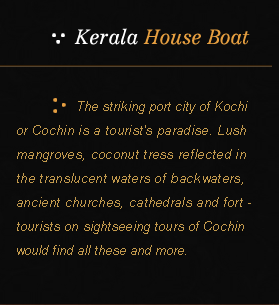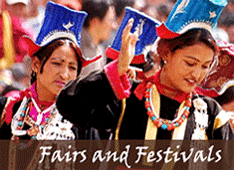
Location : Delhi - Jaipur - Samode - Nawalgarh - Mandawa - Bikaner - Gajner - Jaisalmer - Ossian - Khimsar - Jodhpur - Rohet - Mount Abu - Ranakpur - Udaipur - Dungarpur - Nagda - Deogarh - Ajmer - Pushkar - Pachewar - Ranthambhore - Bharatpur - Agra - Delhi.
Day 01
Delhi Arrival:
COMPANY REPRESENTATIVE will receive you on arrival at the DELHI AIRPORT and transfer to your hotel.
DELHI, the capital of kingdoms and empires is now a sprawling metropolis with a fascinating blend of the past and the present. It is a perfect introduction to the composite culture of an ancient land. A window to the kaleidoscope - that is India.
Overnight will be at Delhi.
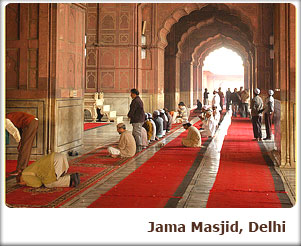 Day 02
Day 02
Delhi:
After breakfast proceed for a day sightseeing tour of the city.
The city is dotted with historic monuments that are the most popular tourist attractions in Delhi. Apart from the monuments, there are museums, markets, gardens and eating joints that you can visit on your tour of Delhi. Some of the important sightseeing places in Delhi are given below.
INDIA GATE: It is the war memorial dedicated to Indian soldiers, who died during World War I. The name of many soldiers who died during World War I is inscribed on its wall. Edward Lutyens, the man who planned and built New Delhi, designed India Gate. Almost every foreign tourist visits the monument. 'Amar Jawan Jyoti', the eternal flame is added later. The eternal flame runs on gas and is a tribute to soldiers who lost their lives in the service of the nation.
RED FORT: Located in Old Delhi, the Red Fort or Lal Quila is a popular tourist attraction in Delhi. The fort was built by the Mughal emperor Shah Jahan in 1648, when he moved his capital from Agra to Delhi. The construction of the Fort started in 1638 and it was completed 10 years later in 1648. Some of the important spots inside the Red Fort include royal baths or Shahi hamams, Shahi Burj, Moti Masjid or the Pearl Mosque, Diwan-e-Aam and Diwan-e-Khas.
JAMA MASJID: The largest mosque in India, the Jama Masjid was built by Shah Jahan 1656 AD. About 5,000 laborers and craftsmen worked for six years to complete the monument. The mosque can accommodate about 25,000 people. The mosque is located in the old Delhi. The domes are built in white marble. The prayer hall of the mosque has 260 pillars.
OLD FORT: Old Fort or Purana Quila as it is called is located near Pragati Maidan on the Mathura Road. You can club a visit to the Old Fort with your tour of Red Fort and Jama Masjid as the three monuments are located in Old Delhi and are not too far from one another. Humanyun’s started the construction of the fort in 1533 AD, but before the completion of the fort, Sher Shah Suri defeated him and captured Delhi. Sher Shah Suri completed the fort and named it -Shergah. He added many structures to the fort, of which Qila-I-Kuhna Mosque and Sher Mandal are worth mentioning. In 1555, Humanyun’s re-captured Delhi and converted Sher Mandal into a library.
HUMANYUN’S TOMB: Humanyun’s Tomb is mausoleum of the Mughal emperor Humanyun’s. Bega Begum also known as Haji Begum, wife of Humanyun’s constructed the mausoleum for her husband. The tomb was built between 1562 and 1572 AD. The tomb was designed by Mirak Mirza Ghiyuth.
QUTAB MINAR: The construction of the Qutab Minar was stated by Qutub-ud-din Aibak in 1199 AD but he died before completing it. His son-in-law and successor Iltutmish completed the construction of the building. Qutab Minar is located in Meharauli.
LOTUS TEMPLE: Also known as the Bahai Temple, the monument was opened to public only in 1986. Located near Nehru Place, the Lotus Temple is designed like a lotus flower. If you are looking for some moments of peace and tranquility in the crowded city, Lotus Temple is the ideal place to visit.
Apart from the above-mentioned sightseeing options, there are various other tourist attractions that you can visit on your tour of Delhi. Some other sightseeing places in Delhi include Lodi Gardens, National Museum, Jantar Mantar, Dilli Haat and the Garden of Five Senses.
Overnight will be at Delhi. 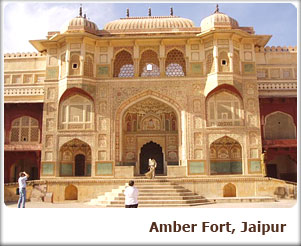 Day 03
Day 03
Delhi – Jaipur:
By Road 260Kms/05hrs
Breakfast will be at the hotel.
Drive to Jaipur. Reach and check into the hotel.
Jaipur is the capital of the state of Rajasthan a romantic realm of resplendent palaces, mighty fortresses and regal Maharajahs that lies in the western deserts and is an utterly unique part of India. Proudly belonging to the KSHATRIYA warrior caste and fiercely independent, the Rajput princes made fearsome foes. However, many of them realized that to maintain their wealth and authority locally, it was expedient to proclaim allegiance to the central power. Thus, many enjoyed a privileged position under the Mughal emperors and also the British Raj that followed.
The bustling Rajasthan capital of Jaipur takes its name from its venerated founder Jai Singh II, who was given the title Sawai Maharaja by the Mughal. Literally translated this would mean ’one and a quarter’, suggesting that the Mughal thought this emperor to be more valuable than just ‘one’. Jaipur is known as the ’Pink City’ on account of the distinctive colour of its buildings. This did not, however, form part of the original plan, but dates back to 1856, when the city was given a wash of pink in honor of a State Visit from Prince Albert.
This evening, visit the Birla Temple to learn more about the fascinating religious life of Jaipur. The marble structure, built as recently as 1985, houses ornate statues including one of Lakshmi (goddess of Wealth and Beauty) and Narayan dressed in gaudy robes, representing a Hindu vision of heavenly luxury. Carvings in the temple and on pillars supporting the covered walkways include images of the Hindu pantheon, as well as Jesus, the Blessed Virgin Mary and St Francis of Assisi. Your visit will coincide with the AARTI Ceremony, which involves oil lamps being lit and waved, in order to awake and invoke the deity.
Enjoy the experience and spend night at Jaipur.
Day 04
Jaipur:
After breakfast drive to Amber Palace. Enjoy Elephant Back ascent to the Fort.
AMER PALACE & FORT: Amer Fort and Palace was originally built by Raja Man Singh and subsequently developed by Sawai Jai Singh. The major attractions are Sheela Devi Temple, Sheesh Mahal (Hall of mirrors), Jai Garh Fort a few kilometers from the city centre was built for the defence of the town and has one of the world’s biggest cannons on wheels and a rich collection of arms and weapons.
Continue city sightseeing.
HAWA MAHAL (PALACE OF WINDS): Hawa Mahal is the most strikingly designed monument in Jaipur. Built by the Poet-King Sawai Pratap Singh in 1799, the Hawa Mahal is centrally located and is multiniched five storey high back view of the compled. It was conceived to provide an adequate vantage position behind delicate stone-carved jali, screens for the palace women to watch the royal processions passing through the Bazar below without being seen by outsiders. The Top of the palace affords a beautiful view of the city. A small archaeological museum is yet another attraction in the palace.
JAL MAHAL: The Jal Mahal Palace, Jaipur is noted for its intricate architecture. The Palace was developed as a pleasure spot. It was used for the royal duck shooting parties. On the road to Amber at a distance of 6.5 Kms from Jaipur are the cenotaphs of the royal family. A causeway leads to Jal Mahal Palace situated in the middle of Man Sagar Lake, opposite the cenotaphs. The first four floors of this building is under water, only the top floor remains outside. One can have a wonderful view of the lake and the palace from Nahar Garh Fort Built in 1799, the palace is now abandoned, but reasonably well preserved. In the monsoons, it looks particularly startling with its red sandstone set against the water hyacinth filled lake.
THE CITY PALACE: The city Palace is a historic landmark. The Carved arches are supported by grey-white marble columns studded with floral motifs in gold and colored stones. Two elephants carved in marble, guard the entrance, where retainers whose families have served generations of the rulers are at hand, to serve as guides.
JANTAR MANTAR Jantar Mantar is one of Sawai Jai Singh’s five remarkable observatories. Constructed with stone and marble its compled instruments, whose setting and shapes are precisely and scientifically designed, represent the high-points of medieval Indian Astronomy. The two Ram Yantras used for gauging altitudes are unique in their isolation. This is the largest of five observatories founded by Sawai Jai Singh-II in various parts of the country.
This evening is free for you to relax shop or explore independently. Shopping is superb in Jaipur, particularly for gold and silver jewellery, pottery, tie-dye materials, silk, saris, wooden handicrafts and carpets.
Overnight will be at Jaipur.
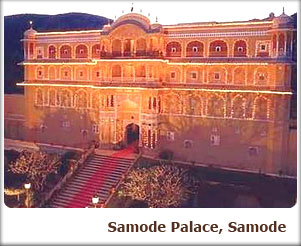 Day 05
Day 05
Jaipur – Samode – Nawalgarh:
By Road 170Kms/04hrs
Breakfast will be at the hotel.
Drive to Nawalgarh visiting Samode enroute.
Samode according to the Rajputana Gazetteer of 1879 was a large and flourishing town. The Zamidars (landlords) of Samode - the principal thakurs of the state of Amber were the Nathawat clan from Chomu, a branch of the house of Amber, tracing their relation to the Jaipur Maharaja the fabled Prithviraj Singhji the 17th prince of the house of Kacchwaha Rajputs. Gopal Singhji one of his 12 sons was awarded Samode, a noble feudatory of the Amber & Jaipur principality. It was among the wealthiest territories in the Amber kingdom. The Zamidari eventually passed within the clan to the hands of Behari Das, a Rajput warrior in Mughal Service. After 6 generations in the hands of his descendants Samode was relinquished to the Raj.
The 400-year-old SAMODE PALACE has a wealth of frescoes, many of them depicting religious subjects. The highlight is a vast DURBAR HALL.
Enjoy sightseeing & take a walk of the Rajasthani.
Continue drive to Nawalgarh. Reach and check into the hotel.
Nawalgarh well mirrors the regal aura of Rajasthan. It abounds in havelis and it is these havelis which are the greatest Tourist Attractions in Nawalgarh. Some of these grand royal buildings date back to the 17th century and startle us with the superb architectural skills they display.
There are one storied havelis as well as five storied ones and many of them have as many as 10 courtyards. Any visitor is sure to be impressed with the frescoes that these havelis are best known for. When you are considering a sightseeing tour of the various Tourist Attractions in Nawalgarh, the havelis which are a must see are the Anandilal Poddar Haveli, Aath Haveli and the Hodh Raj Patodia Haveli. The two forts also constitute the prime Tourist Attractions in Nawalgarh. These imposing structures deserve superlative accolades for their grandeur and magnificence.
The Art Gallery of the Roop Niwas Palace which is presently a heritage hotel is also a must visit in Nawalgarh. The beautiful paintings are a treat to the eye.
The paintings of Aath Haveli depict images of elephants, horses and camels alongside steam locomotives thereby upholding the transition phase of transportation. The miniature paintings of the Murarka Haveli illustrating Krishna legends are to be marveled at for their beauty.
Built relatively recently in the year 1931 and yet one of the premier Tourist Attractions in Nawalgarh is the Hem Raj Kulwal Haveli. Its highly embellished silver gateway containing exquisite religious paintings are admirable. The mirror and blue tile work at the Khedwal Bhawan is emblematic of the dexterity of our craftsmen and is sure to impress one and all.
Precisely the superb frescoes of the magnificent Havelis are Nawalgarh's greatest draw. Make sure to keep at least a day reserved for these Tourist Attractions in Nawalgarh whenever you are on a Tour to Rajasthan.
Overnight will be at Nawalgarh.
Day 06
Nawalgarh – Mandawa – Bikaner:
By Road 230Kms/06hrs
After breakfast proceed to Bikaner visiting Mandawa enroute.
The Tourist Attractions in Mandawa are all about these beautiful forts and Havelis. One of the important tourist attractions of Mandawa is the beautiful Mandawa Fort. Constructed in the year 1797, it was built by the Shekhawati ruler, Nawal Singh. Mandawa Fort is truly a class apart in elegance and grandeur. Beautifully painted murals and paintings, arched doorways, pictures depicting mythological characters recreate the quaint medieval ambience. Around this Mandawa Fort the township of Mandawa slowly developed. Today the fort is not only a mere tourist attraction in Mandawa but it has been renovated into one of the heritage hotels of Rajasthan.
The Hanuman Prasad Goenka Haveli is one of the interesting tourist attractions in Mandawa. In this Haveli you can get to see beautiful paintings which depict Indian mythological characters like Indra Dev and Lord Shiva. The Goenka Double Haveli has a beautiful portico which is tastefully decorated with paintings of elephants and horses. The paintings of Murmuria Haveli are also quite noteworthy which depicts political leaders like Jawaharlal Nehru and a train at a level crossing. The Mohan Lal Saraf Haveli is in a good condition and is adorned with royal portraits.
Continue drive to Bikaner. Reach and check into the hotel.
Bikaner is a beautiful city in the northwestern part of Rajasthan and is a major tourist attraction of the state. Junagarh Fort, camel breeding farm and camel festival are the major tourist attractions of Bikaner. Besides, there are various other tourist attractions of Bikaner like Lalgarh Palace, Deshnoke temple, Karni Mata etc. that you must visit on your Bikaner Travel. The Rajputana Getaway offers to give you online information on other tourist attractions in Bikaner in Rajasthan, India
Famous for its Bikaneri Bhujia, Bikaner offers some of the best spicy snacks and namkeens in India for you to relish. Besides, Bikaner is also famous for its craftwork and leather items which you must purchase on your Bikaner travel.
Overnight will be at Bikaner.
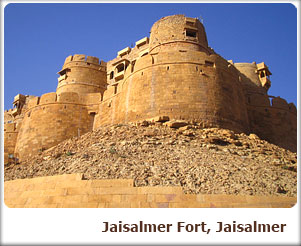 Day 07
Day 07
Bikaner – Gajner – Jaisalmer:
By Road 330Kms/06hrs
After breakfast proceed for the sightseeing.
LALGARH PALACE is a major tourist attraction in Bikaner and is a beautiful structure in red sandstone. Built by Maharaja Ganga Singh in the early 20th century, Lalgarh Palace is a work of art and an architectural masterpiece, designed by Sir Swinton Jacob.
KARNI MATA TEMPLE: is also one of the major tourist attractions of Bikaner. The unique thing about the temple is the thousand of rats that come here. The rats are considered holy and are worshipped by the devotees. You are considered lucky if you spot a white rat.
Drive to Jaisalmer visiting Gajner enroute.
Gajner Palace is a Grand Heritage Palace of the HRH Group of Hotels. Spread over 6000 acres, the palace is a 30-minute drive from Bikaner. Gajner Palace was built on the banks of Gajner Lake by Sir Ganga Singhji, one of the greatest Maharajas of Bikaner, in the early decades of the twentieth century.
Gajner Palace was used as a hunting resort by the former Maharajas and visiting British dignitaries during the days of the Raj. During the reign of Maharaja Ganga Singh, this palace was used for grand shoots and lavish entertainment. Christmas season was often celebrated with prearranged duck and Imperial Sand Grouse shoots. Royalty, Viceroys and other dignitaries were usually invited on these grand occasions.
The red sandstone palace is distinguished for its architectural grandeur and luxuriously appointed suites and rooms. The greenery at Gajner Palace, lawns and the chirping of birds and peacocks make it a truly memorable destination for leisure and corporate travelers.
Reach Jaisalmer and check into the hotel.
Jaisalmer, the Golden City of India, is one of the most alluring tourist destinations in Rajasthan, India. Jaisalmer is famous for its magnificent forts, enchanting palaces, havelis (mansions) and century’s old houses. Jaisalmer is also known for its exotic sand dunes and exciting camel safaris. Jaisalmer has a number of exciting tourist attractions showcasing the royal grandeur of the bygone era. The major tourist attractions in Jaisalmer include the Jaisalmer Fort, Patwon-Ki Haveli, Nathmalji-ki-haveli, Salim Singh-Ki Haveli, Tazia tower, Bar Bagh and the beautiful Gadsisar Lake. Its exquisite handicrafts and colorful festivals are other major tourist attractions.
Jaisalmer also offers exciting shopping experience to its visitors. On tours to Jaisalmer, you can shop for embroidered textiles and carpets, woolen pattu, carpets made from camel hair, tapestry, oil lamps, silver jewelry, finely cut antiques, old stonework, trinkets, and other souvenirs and curios.
Overnight will be at Jaisalmer.
Day 08
Jaisalmer:
JAISALMER FORT: The 12th century Jaisalmer Fort is one of the most formidable forts in Rajasthan, India. Perched on Trikuta hill, Jaisalmer Fort is a 250 ft tall and massive fort surrounded by a 30 ft high sandstone wall with 99 bastions, offering a spectacular sight to visitors. The Fort also houses a Jain Temple.
JAISALMER HAVELIS: Once the residence of wealthy merchants, the havelis (mansions) of Jaisalmer are famous for their artistic designs and decorations. Their exclusive cutwork, yellow and red stone treatment, and the bracket-shaped decoration of peacocks, never fail to mesmerize the visitors. The Patwon-Ki-Haveli, Salim-Singh-Ki-Haveli and Nathmal ji-Ki-Haveli are major tourist attractions in Jaisalmer.
NATHMAL KI HAVELI: Two architect brothers built it in the 19th century. Interestingly, while one concentrated on the right, the other concentrated on the left and the result is a symphony epitomizing the side by side symmetry during construction. Paintings in miniature style monopolize the walls in the interior. Mighty tuskers carved out of yellow sandstone stand guard to the Haveli.
SALIM SINGH KI HAVELI: This Haveli was built about 300 years ago and a part of it is still occupied. Salim Singh was the prime minister when Jaisalmer was the capital of the princely state and his mansion has a beautifully arched roof with superb carved brackets in the form of Peacocks. The mansion is just below the hill and it is said that once it had two additional wooden storeys in an attempt to make it as high as the maharaja's palace, but the maharaja had the upper storey torn down.
PATWON JI KI HAVELI: This is one of the largest and most elaborate Haveli in Jaisalmer and stands in a narrow lane. It is five storeys high and is extensively carved. It is divided into six apartments, two owned by archaeological Survey of India, two by families who operate craft-shops and two private homes. There are remnants of paintings on some of the inside walls as well as some mirror work.
GADSISAR SAGAR LAKE: A famous picnic spot in the sandy city, Gadsisar Sagar Lake is among the most beautiful tourist attractions in Jaisalmer. It attracts hundreds of migratory birds during the winter season. Bara Bagh: Located on the bank of Gadsisar Sagar Lake, Bara Bagh is an oasis in the desert. The lush green garden provides much-needed relief to the local people.
TAZIA TOWER: The pagoda like Tazia Tower rises from the Badal Mahal (Palace of Clouds). The beautiful five-tiered tower is known for its beautifully carved balconies on each storey.
JAIN TEMPLES: These fine Jain temples were built in the 12th to 15th century, within the Jaisalmer Fort. They are beautifully carved and dedicated to Rikhabdevji and Sambhavnathji. The Gyan Bhandar, a library containing some extremely old manuscripts, is within the temple complex.
In the late afternoon, proceed to the SAND DUNES for visiting the typical Rajasthani Desert Village. View the sunset from the dunes, as the sky is set on fire. Return to the village for dinner amidst Rajasthani musicians playing haunting tunes.
Overnight will be at Jaisalmer.
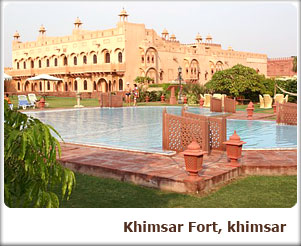 Day 09
Day 09
Jaisalmer – Ossian – Khimsar:
By Road 300Kms/06hrs
Breakfast will be at the hotel.
Proceed to Khimsar visiting Ossian enroute.
OSSIAN: Ossian, known as Ukeshpur in ancient time, is a land of temples. It was a Brahminical centre & later, Jainism also flourished here as is evident from the remnants of medieval temples. The Oswal trace their origin from this place. Ossian is a major site, containing monuments spanning five centuries of artistic evolution. There are several beautiful temples and shrines, oldest amongst them being the Sun temple. The doorway to this temple is one of the finest to be seen anywhere in India. The Harihara I temple, dating back to 750 A.D., is a 'panchayatan' temple, which means that a central shrine is surrounded by four other smaller ones. It stands on a beautifully decorated terrace with thirteen niches built into its sides. The main temple carries some excellent early figural sculptures including the Krishna Leela frieze. The Harihara III temple was built around 800 A.D. the walls of its rectangular sanctum carry exuberant decoration, tastefully executed. There is an open hall, the aisles of which have been provided with a beautiful sloping ceiling supported by rafters, shaped like 'nagas'. Harihara III is one of the finest examples in India of exuberance going hand in hand with architectural strength. Harihara II adjoining Harihara III is a somewhat less well-finished copy of Harihara I. Apart from this there is the main Sun Temples such as Mahavira temple, Vishnu temples III, IV, V, which are also worth seeing for their ancient architectural beauty. A unique feature of these temples is that most of them face the west.
Drive through unbeaten Central Rajasthan and reach Khimser- a remote village.
Visit Khimser Fort, exceptional for its character and ambience.
Overnight stay will be in Khimsar.
Day 10
Khimsar – Jodhpur – Rohet:
By Road 140Kms/04hrs
Breakfast will be at the hotel.
Proceed to Rohet visiting Jodhpur enroute.
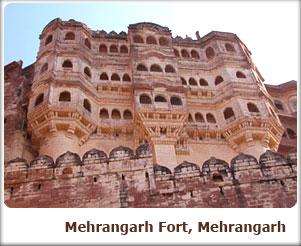 MEHRANGARH FORT: This fort is one of the largest forts in India. The fort is situated at an altitude of about 125 meters and is spread over an area of 5 sq km, with seven gates. It has been a witness to the splendor of bygone era. The beauty and the grandeur of numerous places in the fort narrate a saga of hard sandstones yielding to the chisels of skilled Jodhpur sculptures. Mehrangarh literally means "Majestic Fort". It is located at very center of the city and is visible surrounding from the city. Originally built in 1806 the fort has been added to many times since. The palaces in this fort were built in an informal pattern over several centuries. They have their own peculiar style, with narrow staircases, serving as the only means of access to the royal residences within. A collection of musical instruments, palanquins, furniture and cannons on the fort's ramparts are well - preserved.
MEHRANGARH FORT: This fort is one of the largest forts in India. The fort is situated at an altitude of about 125 meters and is spread over an area of 5 sq km, with seven gates. It has been a witness to the splendor of bygone era. The beauty and the grandeur of numerous places in the fort narrate a saga of hard sandstones yielding to the chisels of skilled Jodhpur sculptures. Mehrangarh literally means "Majestic Fort". It is located at very center of the city and is visible surrounding from the city. Originally built in 1806 the fort has been added to many times since. The palaces in this fort were built in an informal pattern over several centuries. They have their own peculiar style, with narrow staircases, serving as the only means of access to the royal residences within. A collection of musical instruments, palanquins, furniture and cannons on the fort's ramparts are well - preserved.
JASWANT THADA: Close to the fort complex lies white marble cenotaph, built in 1899 in commemoration of Maharaja Jaswant Singh II rare portraits of Jodhpur rulers are also to be seen at Jaswant Thada. A visit inside the cenotaphs, with some villagers of the region, would bring forward the reverence they still hold for their brave kings.
Continue drive to Rohet. Reach and check into the hotel.
ROHET is the fortified desert home of the descendants of the 16th century Rathore of the Champawat clan, Thakur Dalpat Singh I. The "Jagir" (Fiefdom) of Rohet was bestowed upon him in 1622 A.D. by the Maharaja of Jodhpur, as a mark of appreciation for his bravery in battle. Generations of valiant noble-men have built this heritage home where, notwithstanding the inroads of modernity, aristocratic values are respected. The visitor of today experiences the famed warmth of courteous Rajput hospitality.
Brilliantly plumed peacocks strut about, perching themselves under finely carved stone archways and the wind whispers through the neem tree groves and bougainvilleas.
Rohet Garh is a recognized Heritage Hotel. Rare among hotels it has remained a family home, where the members of the erstwhile ruling family welcome you personally as their honored guest. Its elegantly appointed rooms have their own individual character and furnishings. Rooms are air-conditioned and have attached bathrooms and modern facilities. The drawing room has ornately carved wooden ceiling, traditional lamps and old photographs. You are invited to relax in spacious verandah lounges decorated with historic trophies and artifacts.
There is a beautifully designed swimming pool with four charming pavilions at each corner where musicians perform in the evenings as dinner is served by the poolside. Often, folk dancers enliven the evenings with their vibrant hues and vigorous rhythms.
Overnight will be at Rohet.
Day 11
Rohet:
Breakfast will be at the hotel.
Drive to the BISHNOI VILLAGES for a short jeep safari.
Visit the BISHNOI VILLAGES and have a rare glimpse into the rich culture and true essence of India. This village is inhabited by the Bishnoi community. They are staunch believers in the sanctity of plant and animal life. Villages are marked by Khejri trees and deer which thrive. Memorable moments of the great desert landscape fascinates one while driving along the countryside.
Overnight will be at Rohet.
Day 12
Rohet – Mount Abu:
By Road 225Kms/05hrs
Breakfast will be at the hotel.
Drive to Mount Abu. Reach and check into the hotel.
These beautifully carved temples built between 11th and 13th century AD are sheer elegance in marble, dedicated to the Jain Tirthankaras. The Vimal Vasahi temple is the oldest of these dedicated to the first Tirthankaras. Built in 1031 A.D. (by Vimal Shah - a merchant and representative of the then Gujarat ruler), it is a superb example of temple architecture. The central shrine has an image of Rishabhdev and large courtyard with 52 small shrines, each housing a beautiful statue of tirthankaras with 48 elegantly carved pillars form the entrance to the courtyard. The Lun Vasahi Temple, dedicated to the 22nd Tirthankaras - Neminath, was built in 1231 A.D. by two brothers - Vastupal and Tejpal, Ministers of Raja Vir Dhawal, a ruler of Gujarat - belonging to the Porwal Jain community. With door casings, pillars, architraves, and sculptures on porticos, the temple is a fine specimen of craftsmanship.
Overnight will be at Mount Abu.
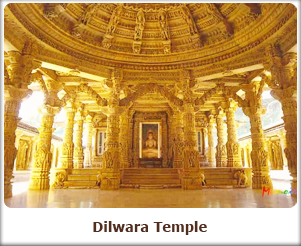 Day 13
Day 13
Mount Abu:
Breakfast will be at the hotel.
Proceed for the sightseeing….
GAUMUKH TEMPLE: Gaumukh temple served as the venue for Sage Vashishtha's yagna. The temple has got its name from a nearby natural spring that surges through a carved cow's head. Forming the background of the temple is a sculpted hill temple of Arbuada (the mighty serpent). Close to it is a splendid marble image of Nandi, a celestial bull that Arbuada rescued.
DILWARA JAIN TEMPLE: Mt. Abu, Rajasthan sightseeing tour is incomplete without a visit to the famous Dilwara Jain temples. Built between 11th and 13th century AD, these temples are made up of carved marble. The temples are dedicated to the Jain Tirthankaras. There are five Dilwara temples in Mt. Abu. Out of these, the oldest one is Vimal Vasahi, dedicated to the first Tirthankara. All the Dilwara temples are a marvelous example of temple architecture.
ADHAR DEVI TEMPLE: Adhar Devi temple is situated approximately 3 km to the north of Mount Abu. Reached by a flight of 360 stairs, the temple was carved out of a huge rock and is dedicated to Goddess Durga.
SHRI RAGHUNATHJI TEMPLE: Shri Raghunathji temple is located near Nakki Lake. Dedicated to Shri Raghunathji, it houses a gorgeous image of the deity placed by Shri Ramanand in 14th century A.D.
SUNSET POINT: Mount Abu also has a sunset point providing a magnificent view of the setting sun.
Overnight will be at Mount Abu.
Day 14
Mount Abu – Ranakpur – Udaipur:
By Road 230Kms/05hrs
Breakfast will be at the hotel.
Drive to Udaipur visiting Ranakpur enroute.
The RANAKPUR TEMPLES, dating back to the 15th century have 200 pillars, none of which are alike, support its 29 halls. The Temple abounds with intricate friezes and sculptures. Includes visits to two more Jain temples and the Temple of the Sun God with its erotic sculptures.
Reach Udaipur and check into the hotel.
The city of Dawn, Udaipur is a lovely land around the azure lake, hemmed in by the lush hills of the ARAVALLIS. A vision in white drenched in romance and beauty, Udaipur is a fascinating blend of sights, sound and experiences and inspiration for the imagination of poets, painters and writers.
Its kaleidoscope of fairy-tale palaces, lakes, temples, gardens and narrow lanes strewn with stalls, carry the flavor of a heroic past, epitomizing valor and chivalry. Their reflection in the placid waters of the LAKE PICHOLA is an enticing sight. Udaipur is the jewel of MEWAR -a kingdom ruled by the Sisodia dynasty for 1200 Years.
Overnight will be at Udaipur.
Day 15
Udaipur:
Breakfast will be at hotel.
CITY PALACE: Udaipur’s fascinating City Palace is the largest royal complex in Rajasthan. Standing on a rocky promontory the palace has balconies, towers and cupolas and presents a wonderful view of the lake and the city. The complex has eleven constituent Mahals (palaces), constructed by successive maharanas during the three hundred years that followed the foundation of Udaipur in 1559. Added to this, Crystal Gallery and Durbar Hall within the complex is spectacular. Explore them for their mosaics, miniatures, mirror work and motifs.
Here you will marvel at rooms with mirrored walls and ivory doors, colored glass windows and inlaid marble balconies and the Peacock Courtyard.
SAHELION KI BARI: The "garden of the maids of honour", Sahelion-ki-Bari was designed and laid out early in the eighteenth century as a retreat for ladies of the royal household to spend their time in leisure. The lotus pool, fountains, lawns, flowerbeds, and marble pavilions all combine to make it a captivating place.
BAGORE KI HAVELI: Situated on the picturesque bank of Pichola Lake, This Haveli was built by Shri Amarchand Badwa, who was the Prime Minister of Mewar-the rulers of Mewar Pratap Singh, Maharana Ari Singh, and Maharana Hamir Singh during the period 1751 to 1778. This palatial building reportedly has 138 rooms, balconies, terraces, courtyards and corridors. The glass and mirror inlay within the Haveli is Unique and procured in its original form. The two peacocks made with small pieces of colored glasses are unique reflection of the finest craftsmanship of glass work. What was once upon a time a living centre of nobility of Udaipur lay in darkness and ruin for nearly half a century till when it was handed over to the West Zone Cultural Centre (WZCC) in 1986.
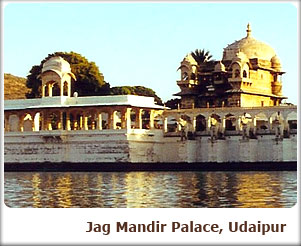 JAGDISH TEMPLE: Built in 1651 A.D. by Maharana Jagat Singh, this Indo-Aryan temple is dedicated to Lord Jagannath, a manifestation of Vishnu. The largest and the most beautiful temple of Udaipur, it is always seething with constant activity and noted for its beautiful sculpted images and towering Shikhara.
JAGDISH TEMPLE: Built in 1651 A.D. by Maharana Jagat Singh, this Indo-Aryan temple is dedicated to Lord Jagannath, a manifestation of Vishnu. The largest and the most beautiful temple of Udaipur, it is always seething with constant activity and noted for its beautiful sculpted images and towering Shikhara.
FATEH SAGAR: West of Sahelion-ki-Bari is Fateh Sagar, a lake built by Maharana Fateh Singh. It is bordered by sharp hills and a canal built at the beginning of the twentieth century connects it to the Lake Pichola. In the middle of the lake is Nehru Park, a popular garden island with a boat-shaped cafe.
BHARATIYA LOK KALA MANDIR: Bharatiya Lok Kala Mandir is home to an attractive collection of folk dresses, puppets, ornaments, dolls, masks, folk musical instruments, folk deities and paintings. The museum is the best place for those interested in puppetry. Short amusing puppet shows are staged throughout the day. In addition, the museum runs short courses in puppet making and theatre.
Proceed for Evening Motor launch cruise on the placid waters of Lake Pichola. From the boat you will be able to view the city of Udaipur as it rises majestically above the lake in the middle of the Rajasthan desert. Also visit the Jag Mandir Palace - the other island palace in the middle of the lake. Spend some time at the Jag Mandir Palace.
JAG MANDIR: Jag Mandir, another island palace in the Lake Pichola was built by Karan Singh in 1615. It derives its name from Jagat Singh who added to the initial structure. It was never used for the purpose for it was built. This palace was used to provide shelter to the Mughal prince Khurum (later Emperor Shah Jahan) who rebelled against his emperor father Jahangir, in the 1620s. Jahangir was succeeded by Shah Jahan who was still in Udaipur at the time of his father's death. During the 1857 Mutiny this island palace once again served as a safe haven for European women and children.
Overnight will be at Udaipur.
Day 16
Udaipur – Excursion to Dungarpur:
Breakfast will be at the hotel.
Proceed for an excursion to Dungarpur.
Albeit a small town in Rajasthan, Dungarpur attracts a sizable number of tourists. The town is situated in the south of Rajasthan. The legend has it that Dungarpur once used to be a Bhil Pal or the village of Dungaria, a Bhil chief. It is from him that the city got its name. It is believed that Rawal Veer Singh assassinated Dungaria and founded the city of Dungarpur (the City of Hills) in 1282. Dungarpur, once, used to be a major territory of the Vagad region with Vatpadrak (present Baroda) as its capital.
Juna Mahal: One of the main tourist attractions of Dungarpur is the Juna Mahal. It is a seven-storied structure that resembles a fortress, dating back to the 13th century. Crenulated walls, towers, narrow access ways and passages were built in this fortress to impede the enemy. Adorning the interiors of the Mahal are beautiful frescoes, miniature paintings and exquisite glass and mirror work. The royal family of Dungarpur still resides inside the palace.
Udai Bilas Palace; Maharwal Udai Singh II built this palace to serve as the royal residence. The palace, a magnificent example of Rajput architecture, is adorned with sculpted pillars and panels, balconies and spectacular arches.
Gaib Sagar Lake: The famous places to see in Dungarpur include the Gaib Sagar Lake. Set amongst scenic environs, the lake is a bird watcher's paradise. The picturesque surroundings of the lake house numerous species of birds. Also situated along the lake is a famous Shrinathji temple. The temple complex has a number of beautifully built shrines inside it, with one being the main temple. One of them is the Vijay Raj Rajeshwar Temple that is dedicated to Lord Shiva.
Rajmata Devendra Kunwar State Museum and Cultural Centre: Rajmata Devendra Kunwar State Museum and Cultural Centre, Dungarpur" was opened to the general public in the year 1988. The museum has a beautifully sculpture gallery that brings to fore the history of Vagad Pradesh, which spreads over present day Dungarpur, Banswara and Kherwara
Overnight will be at Udaipur.
Day 17
Udaipur – Nagda – Deogarh:
By Road 120Kms/02hrs
Breakfast will be at the hotel.
Proceed to Deogarh visiting Nagda enroute.
 Nagda is the ancient capital of Mewar, lying midway between Udaipur and Nathdwara and located next to the Bagela Lake. There is a group of 108 temples here. Legend has it that it was founded by Nagaditya, the fourth Mewar King in the 6th century and was a stronghold of the Sisodia Empire.
Nagda is the ancient capital of Mewar, lying midway between Udaipur and Nathdwara and located next to the Bagela Lake. There is a group of 108 temples here. Legend has it that it was founded by Nagaditya, the fourth Mewar King in the 6th century and was a stronghold of the Sisodia Empire.
Reach Deogarh and check into the hotel.
Deogarh lies on the borders of Mewar, Marwar and Merwara, about 80 miles north-east of Udaipur. Its chieftain known as 'The Rawat' was one of sixteen umraos (feudal barons) privileged to wait upon the Maharana of Udaipur, the capital of Mewar. Such feudal estates, called thikanas were granted by the ruling Maharana to a nobleman either due to blood relationship or for an act of bravery. Deogarh is also renowned as a school of miniature painting. Some Deogarh miniatures adorn the personal collection of the present Rawat Sahib. Frescoes of this art form can also be seen on the fort walls. The Mahal also has some exciting rooms to browse through - Sheesh Mahal - the colorful hall of mirrors, is just one of them.
Deogarh Mahal is an imposing structure built in the 17th century. It stands atop a hill and offers a commanding view of the Aravalli mountain range and the numerous lakes, strewn across the countryside. With its old battlements, domes, turrets, jharokhas and huge gateways, it is a picturesque sight from the town below. At a height of about 2100 ft above sea level, it is cooler than surrounding Rajasthan. Built in 1670 A.D. by Rawat Dwarka Dasji as a family residence, it soon became the hub of village activity. The family interacted with the villagers and invited a host of feasts and festivities to be performed within the Mahal precincts. Some of these traditions are still practiced. And the gates, that always remained closed, to ward off enemies, are now open to the guests.
Deogarh Mahal was converted into a hotel about 15 years ago, by the present owner Rawal-Nahar Singh. A part of the Mahal is still occupied by his kin. The family is closely associated with the hotel and personally supervises and monitors the on goings. The care is reflected in the minutest details which have made Deogarh a benchmark of Heritage Hospitality in Rajasthan.
Proceed for sightseeing of the place around the town.
ANJANESHWAR MAHADEV: It is an extraordinary cave temple believed to be 2,000 years old. This ruined temple is situated on an island in the Raghosagar Lake.
GOKAL VILAS: This magnificent palace situated over a hillock is the home of the present Rawat. Set in a picturesque locale around Raghosagar Lake, the palace is around 200 years old.
Enjoy your day walking the town and meeting the villagers.
Overnight will be at Deogarh.
Day 18
Deogarh – Ajmer – Pushkar – Pachewar:
By Road 225Kms/05hrs
After breakfast proceed to Pachewar visiting Ajmer & Pushkar enroute.
Ajmer is the most sacred of all Muslim places of pilgrimage in India. Ajmer is famous for the Dargah (Tomb) of the Sufi Saint Khwaja Moinuddin Chisti. It is one of the very few Rajasthani places that came directly under the rule of the British. Some other places of interest are the Anasagar Lake and there are some gardens like Daulat gardens. At the heart of the city lies the Ana Sagar Lake which tends to dry up in the summer. The place has gained immortality due to the aura and legend of Sufi Saint Khwaja Moinuddin Chisti. His Dargah is an experience in itself.
Brahma Temple: The most famous and visited tourist attraction of Pushkar is the Brahma Temple. It is the only temple of Lord Brahma (creator of the world) in the whole world. The temple was constructed in the 14th Century. It houses a life-size statue of Lord Brahma. The temple is made up of marble and is its floor is decorated with silver coins, donated by the pilgrims.
Pushkar Lake: The legend behind the Pushkar Lake is that the lake originated when some Lotus petals fell on Earth from the hands of Lord Brahma. Surrounding the lake, are 52 ghats, each having water with special powers. The Pushkar Lake also serves as the venue for the renowned Pushkar fair held every year.
Savitri Temple: The Savitri temple is dedicated to Goddess Savitri, the wife of Lord Brahma. Positioned on the Ratnagiri Hill, this temple holds a legend to itself. It is believed that once Lord Brahma had to perform a Yagna immediately. However, the performance of the Yagna required the presence of his wife. So, he married a local milkmaid, Gayatri for the purpose. When Brahma's wife, Savitri, found out, she cursed Lord Brahma that he would be worshipped only in Pushkar and only once a year. Then, she immolated herself at the Ratnagiri Hill, where the temple now stands.
Warah Temple: The Warah temple is dedicated to Lord Vishnu (preserver of the world). King Anaji Chauhan built this temple. The temple has an image of lord Vishnu in the incarnation of a wild boar. The legend has it that Lord Vishnu came took the form of a Warah (wild boar) to kill the demon Hirnayaksh.
Reach Pachewar and check into the hotel.
Pachewar – India. A great land of culture offers equally great destinations like Rajasthan, where valour, chivalry and royalty have played a great deal in shaping the glorious traditions of its land and people.
Pachewar – 90 Kms away from Jaipur capital of Rajasthan, is a mute yet vibrant, silent but lively village, once ruled by Khangarot Rajputs, a subclan of Kachhawas-the rulers of erstwhile Jaipur State. Thakur Anoop Singh Khangarot, then Qiledar of Khandar, captured the fort of Ranthambhore from the Marathas and annexed it into Jaipur State. To reward his exemplary courage and loyalty to Maharaja Sawai Madho Singh-I of Jaipur granted him the fief of Pachewar in 1758, A.D.
Fort of Pachewar, 300 years old fort of picturesque Pachewar has now been converted into a luxurious heritage hotel with all modern amenities, where one can witness great traditions of royal hospitality. A well preserved tranquil fort with its massive ramparts imposing gates, intricate balconies and spacious apartments, adorned with antique frescos of exquisite beauty. To Pachewar is only 25 minutes drive from Dudu a small town – situated on Jaipur-Ajmer National Highway on Dudu-Malpura road, renowned for its traditional textiles.
Overnight will be at Pachewar.
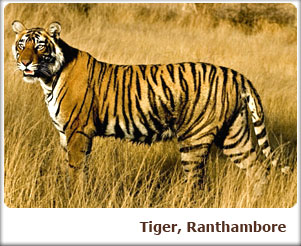 Day 19
Day 19
Pachewar – Ranthambhore:
By Road 175Kms/04hrs
Breakfast will be at the hotel.
Explore rural village life.
The itinerary of local sightseeing includes a visit to the royal cenotaphs, built on the banks of Pumpa Sagar Lake, ancient temples and intimate exposure to the village – life, where you can watch the village craftsmen and artisans creating delicate blue pottery, cozy carpets, colorful tie and dye, and terracotta. Nomadic ‘Gadia-Luhars’ (iron-smiths) tempering the red-hot iron carrying their entire house-hold in a single bullock-cart can also be watched here.
Enjoy the colours of life, in a truly Rajasthani way – a synonym of hospitality intimacy and friendliness.
Drive to Ranthambhore. Reach and check into the hotel.
Ranthambore National Park is in Sawai Madhopur District of Rajasthan state. Located at the junction of the Aravalli and Vindhya hill range, this is one of the finest places to view animals, especially as they are used to being stared at here. The park covers an area of Approximately 400 sq Km and if combined it with the area of sawai man Singh sanctuary area, it is around 500 Sq km.
Ranthambore national park was declared a wildlife sanctuary in 1957 and in 1974 it gained the protection of "Project Tiger". It got its status of a National Park in 1981. Ranthambore National Park is dotted with structures that remind you of bygone eras. There are many water bodies located all over the park, which provide perfect relief during the extremely hot summer months for the forest inhabitants. A huge fort, after which the park is named, towers over the park atop a hill. There are many ruins of bygone eras scattered all over the jungle, which give it a unique, wonderful and mixed flavor of nature, history and wildlife. Tigers at Ranthambore National park have been known to even hunt in full view of human visitors. These tigers are famous for being seen in the daytime too, due to their lack of fear of human presence in vehicles. This lack of fear of humans is excellent for tourists, as they get to see the tigers often.
This National park is a wildlife enthusiast and photographer's dream. It offers excellent accommodation and internal transportation facilities. The park remains open every year from October to May. Famous for the exciting and frequent tiger sightings captured dramatically in several books, this park is today affected by ecological pressures and poaching.
In Nutshell, Ranthambore National park is a wildlife enthusiast and photographer's dream.
Timings for entry into, and exit from, the park vary according to the season. In winters, due to the shorter duration of daylight hours, the morning entry time is later and evening exit time is earlier.
Overnight will be at Ranthambore.
Day 20
Ranthambhore:
Wake up early morning and leave for your safari into the National Park. Track the tigers and other wildlife through the morning. Return to the resort / lodge by 1000 in the morning and have breakfast.
Freshen up and either spends time at the pool or visit the town. You could also go for a nice visit to the temple on top of the fort.
In the afternoon have lunch and then leave again for you afternoon safari. The safari will be till evening 1700 – 1800 hr and then return to the resort / lodge.
Dinner will be at the resort and retire early for the night.
Overnight will be at Ranthambhore.
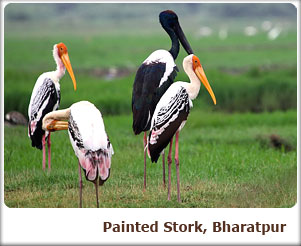 Day 21
Day 21
Ranthambhore – Bharatpur:
By Road 250Kms/05hrs
Breakfast will be at the hotel.
Proceed to Bharatpur. Reach and check into the hotel.
Bharatpur, an erstwhile princely state of the Jat rulers, was founded by the great Maharaja Suraj Mal, who also once conquered Delhi. Maharaja Suraj Mal built the fort at Bharatpur as also the beautiful palaces and gardens at Deeg. The Keoladeo Ghana National Park is one of the finest water-bird sanctuaries in the world. The Maharaja of Bharatpur artificially created the lake and wetland in the 19th century. The marshes of Keoladeo (area 24 sq km, established in 1956 as a bird sanctuary, 1981 as a National Park), were the private hunting reserves of the Maharajas, and was developed in the late 19th century by creating small dams to collect rain water and by feeding it with an irrigation canal. Over the years, the lakes attracted great numbers of waterfowl and the Maharajas held grand shoots with family, friends and visiting dignitaries.
Commonly referred to as Bharatpur, the Park is a delight for bird watchers. Over 375 species of birds are found here and raised paths, camouflaged by babul trees and undergrowth make viewing easy. A quiet ride by boat in the early hours of the morning is also unforgettable experience. The cacophony is unbelievable as painted storks, open bills, spoonbills, egrets, cormorants, white ibis and multitudes of others, tend their young. Jacanas with their iridescent colors and elegant tail feathers and purple moorhen can be seen delicately treading over the floating vegetation.
The Park has over 400 resident and migrant bird species, including the Common, Demoiselle and the rare Siberian Cranes. As well as mammals like Striped Hyena, Fishing Cat, Golden Jackal, Jungle Cat, Nilgai, Sambar, Blackbuck, wild Boar and Indian Python.
Proceed on RICKSHAW for viewing the birds. RICKSHAW PULLERS have been trained by the forest department in bird watching and are knowledgeable.
Overnight will be at Bharatpur.
Day 22
Bharatpur – Fatehpur Sikri - Agra:
By Road 55Kms/01hr
Enjoy Birding.
Breakfast will be at the hotel.
Drive to Agra visiting Fatehpur Sikri enroute.
FATEHPUR SIKRI – THE CITY OF VICTORY: 37 Kms from the city of Agra, stands Fatehpur Sikri, Akbar’s capital. Full credit goes to the Archeological Survey of India for this perfectly preserved example of a Mughal city at the height of the empire’s splendor. It is an attraction no visitor to Agra should miss. This sprawling structure is made of red sandstone and combines both Hindu and Mughal architecture. This walled city contains the mausoleum of the Sufi fakir, Saleem Chisti who is said to have granted Akbar and his Hindu queen Jodhabai their wish for a son. The main entrance to Fatehpur Sikri is through the 175 feet Buland Darwaza, the highest gateway in the world. It was built by Akbar to commemorate his victory over Khandesh in Gujarat. The Panch Mahal is a five-storeyed tower, the highest point in Fatehpur Sikri. This extremely airy tower is supposed to have been used by one of the emperor's many queens.
Reach Agra and check into the hotel.
AGRA: Two great Mughal monarchs, Akbar and Shah Jahan, transformed the little village of Agra into a befitting second capital of the Mughal Empire – giving it the name Dar-ul-Khilafat {seat of the Emperor}. Today a visitor to Agra is caught up in a world of contrasting edifices, of red sandstone and white marble, narrow galleys and quaint buggies, and that irresistible charm that this favorite city of the Mughals still retains. It is not surprising, that modern Agra still reflects its Mughal heritage most conspicuously. A walk down the narrow bustling streets of the city will introduce the visitor to the wafting aroma of Mughlai cuisine.
Overnight stay will be at Agra.
Day 23
Agra:
After breakfast proceed for day sightseeing of Agra.
THE TAJ MAHAL – AN EMPEROR’S LAMENT: Agra is the city of the Taj Mahal. It is a sublime experience of the greatest love story ever told. Today India's most fascinating and beautiful masterpiece, this perfectly symmetrical edifice is set amidst landscaped gardens on the banks of the Yamuna River. The Taj was built by the Mughal Emperor Shahjahan as a memorial to his wife, Mumtaz Mahal. After her untimely death, Shah Jahan had her mortal remains buried in this mausoleum. And after his own demise he was placed to rest next to his beloved queen in the same mausoleum. Under the dome, below the ground level, in a dimly lit chamber, lie the mortal remains of Shahjahan and his beloved queen Mumtaz, reminding the world of their undying love. The Taj remains closed for visitors on Friday
AGRA FORT – ARCHITECTURAL WONDER IN STONE: Within a radius of 3 kilometers, on the banks of the river Yamuna raises the crescent like Agra Fort. Designed and built by Akbar in 1565 A.D., the fort is surrounded by a 70 feet high wall. It houses the beautiful Pearl Mosque and numerous palaces including the Jahangir Mahal, Diwan-i-Khas, Diwan-i-Am and Moti Masjid. Later it was used by his son Jahangir also as the seat of power. Shahjahan modeled his creation, the Red Fort at Delhi on this fort. The Agra fort happens to be on the same bank of the river Yamuna as the Taj Mahal which is visible in all its beauty from one side of the fort. So very ironically, Shahjahan, a prisoner of his son Aurangzeb in his old age was put in a cell from where he could gaze at the Taj Mahal at a distance, from his cell in the Agra Fort.
The fort has four gates and is enclosed by a double barricaded wall of red sand stone. Many buildings were constructed within the fort of which very few remain till date. One of the most significant ones is the multi storied Jahangir Mahal built by Akbar for his wife Jodha Bai. The Mahal is reached through an impressive gateway and its inner courtyard consists of beautiful halls, profuse carvings on stone, exquisitely carved heavy brackets, piers and cross beams.
ITMAD – UL – DAULAH’A TOMB: This tomb was erected by Nur Jahan in sweet memory of her father Ghiasud-Din-Beg between 1622-1628 A.D. This white marble structure of the pre-Taj era though smaller is often considered equal if not better to the great one itself.
Overnight stay will be at Agra.
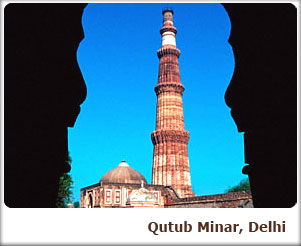 Day 24
Day 24
Agra – Sikandra – Delhi:
By Road 202Kms/04hrs
Breakfast will be at the hotel.
Drive to Delhi visiting Sikandra enroute.
SIKANDRA: Sikandra, 10 Kms North West of Agra, is the final resting place of Emperor Akbar. The Tomb of Akbar shows an interesting fusion of Hindu and Mughal architecture reflecting the spirit of the Mughal Emperor Akbar. Akbar began the construction of his own garden mausoleum during his lifetime, a red sandstone structure in a char-Bagh meaning 4-square formal garden.
Reach Delhi and enjoy last minute shopping.
As per your INTERNATIONAL FLIGHT TIMINGS you’ll be transferred to the airport to take your flight back home with sweet memories of TOUR.
...........................................................................TOUR ENDS...........................................................................INCLUSIONS:
- ACCOMODATION AT SUGGESTED HOTELS,
- DAILY BUFFET BREAKFASTS,
- AC VEHICLE WITH THE DRIVER FOR ALL TRANSFERS & SIGHTSEEING AS PER THE ITINERARY,
- MEET AND ASSIST AT THE AIRPORT/STATION ON ARRIVAL/DEPARTURE,
- ENGLISH SPEAKING LOCAL GUIDES AT PPLICABLE PLACES
- RICKSHAW RIDE IN DELHI,
- ELEPHANT RIDE AT AMER FORT, JAIPUR,
- SAND DUNES CAMEL RIDE & DINNER IN JAISALMER,
- BISHNOI VILLAGE VISIT IN ROHET,
- BOAT RIDE AT LAKE PICHOLA IN UDAIPUR,
- JEEP SAFARIS IN RANTHAMBHORE,
- ALL MEALS IN RANTHAMBHORE,
- NATIONAL PARK ENTRANCE FEES,
- RICKSHAW RIDE IN BHARATPUR,
- FATEHPUR SIKRI EXCURSION,
- HORSE CART RIDE TO TAJ MAHAL IN AGRA,
- TOLL TAXES, DRIVER ALLOWANCE, PARKING, AND
- ALL APPLICABLE TAXES AND SERVICE CHARGES.
EXCLUSIONS:
- LUNCHES & DINNERS,
- MONUMENT ENTRANCES,
- CAMERA CHARGES AT THE MONUMENTS,
- PORTER CHARGES,
- TIPS &
- PERSONAL EXPENSES.

